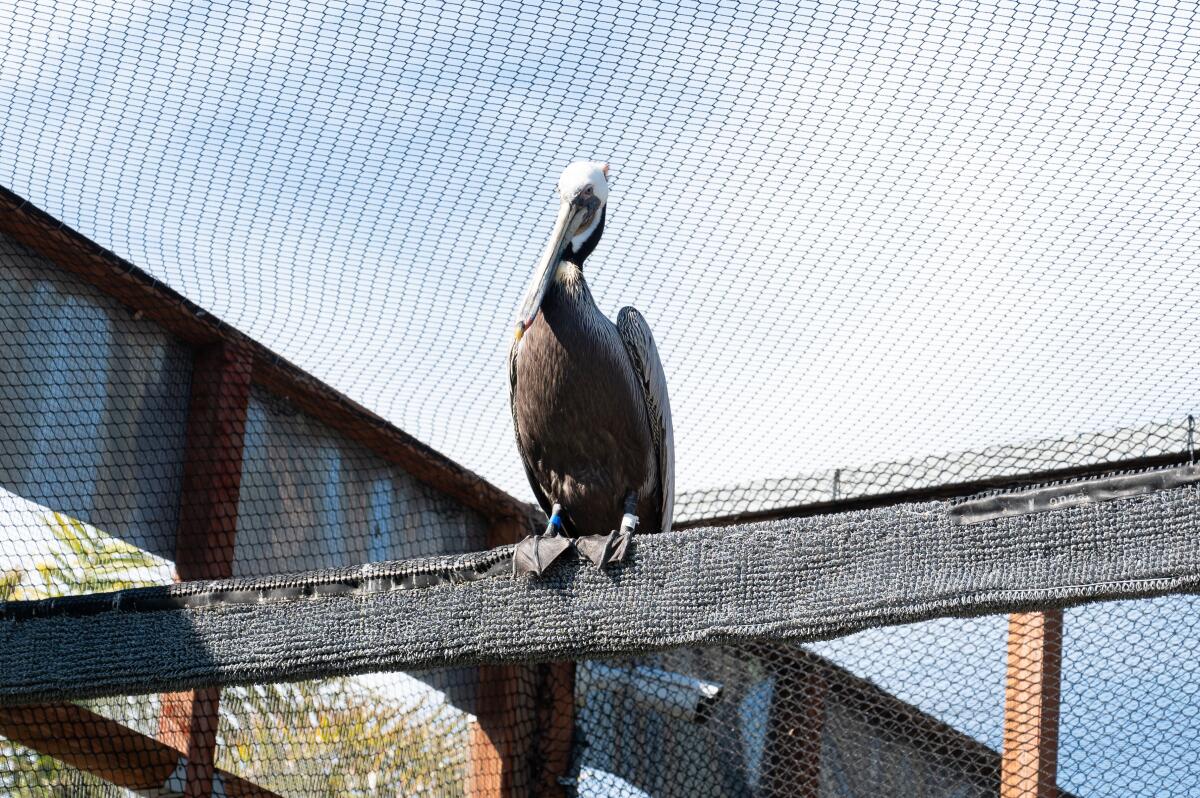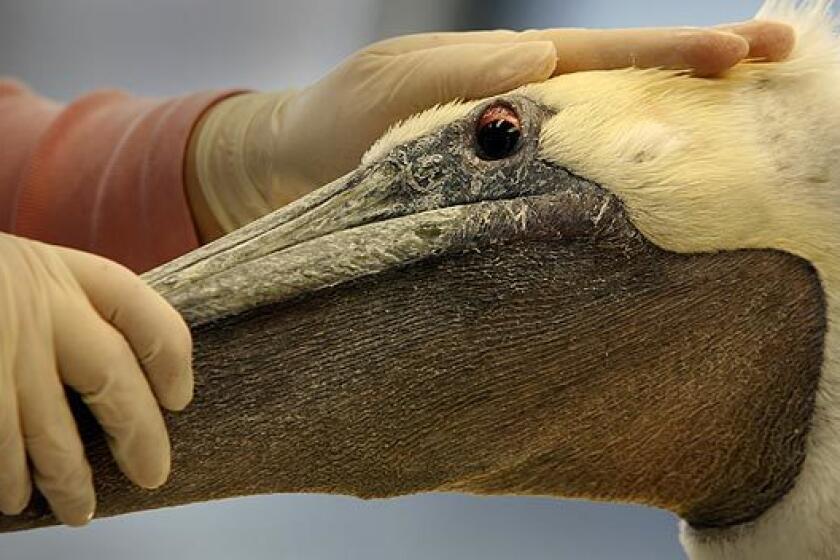500 stitches later, injured brown pelican ‘Blue’ continues healing process

- Share via
A 3-year-old brown pelican hobbled about the San Pedro Pier, injured and unable to feed itself for at least a day.
Cuts ran parallel to the jaw, straight and through to the back of the neck and into the feathered skin, according to reports from a bird rescue group.
A member of a local sport-fishing crew spotted the disoriented bird March 10 and tossed it a fish. The pelican caught it with its beak, but the snack slid out of its exposed and damaged pouch.
The fisherman drove the bird two miles to International Bird Rescue, which is known for providing care and rehabilitation services.
The organization announced Thursday that the brown pelican, christened “Blue,” is improving, “eating with bravado” and has gained nearly two pounds.
“We got the bird quickly, and it’s fair to say that Blue is on the road to recovery,” said Russ Curtis, the group’s communications manager. “The bird is eating, and it has a bright future.”
Curtis said the pouch is a “vital organ” for brown pelicans that allows the birds to scoop up and swallow fish.

“If it’s cut, it’s a death sentence,” Curtis said.
Curtis said Blue required 400 immediate stitches, performed by the organization’s chief veterinarian, Dr. Rebecca Duerr. Another 100 stitches were added after Blue rested for five to six days, to sew up the rest of the exposed mouth area, Curtis said.
“The back of Blue’s mouth required careful reconstruction but came together well,” Duerr said.
Blue spent Friday morning and afternoon in International Bird Rescue’s flight aviary. The group posted a YouTube video Thursday of the brown pelican attempting to grab small fish out of a blue crate.
“We want to thank the bird lovers of Southern California and beyond for their support of our efforts to save Blue,” Chief Executive JD Bergeron said in a statement.
Duerr and other International Bird Rescue staffers believe humans inflicted the injuries on the bird.
Five years ago, the bird was removed from the endangered species list it had inhabited for many years. But it’s not ‘mission accomplished.’
“We see many pelicans with pouch trauma due to fishing gear and eating dangerous, sharp items like fish skeletons, but the wounds do not look like this,” said Duerr, director of research and veterinary science. “The cuts are reminiscent of a knife, machete or other sharp object.”
The injuries reminded staffers of an attack 10 years ago on a Long Beach brown pelican called “Pink.” International Bird Rescue officials labeled that incident “the worst deliberate pouch slashing we’ve ever seen.”
Pink needed two surgeries and almost two months of recovery at the same aviary where Blue is convalescing. Pink was released at San Pedro’s seaside White Point Park in June 2014. Blue was named as an homage to Pink.
The assault on Blue is the first one thought to be by a human that International Bird Rescue has come across this year, according to Curtis.
“I don’t know what would lead a person to attack a bird, out just looking for food, so cruelly,” he said. “It’s a sad statement about the world.”
The injury was reported to the California Department of Fish and Wildlife for investigation.
Capt. Patrick Foy, a member of the department’s enforcement division, said he was aware of a handful of birds with injured pouches over the last several years between Ventura and Dana Point. However, his division could not identify what or who was wounding them.
“There’s no doubt these birds have been horribly injured,” Foy said. “Whether it’s caused by a human has not been proven yet.”
Foy said his department could not conclude that a human was responsible for the attacks until the animals are inspected.
Until then, he said, “we have an investigation that is ongoing, but we have very little to go on.”
Foy and International Bird Rescue have a tip line at 888-334-2258 and hope members of the public will provide information.
More to Read
Sign up for Essential California
The most important California stories and recommendations in your inbox every morning.
You may occasionally receive promotional content from the Los Angeles Times.















